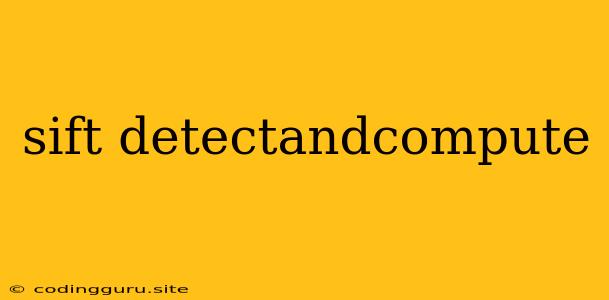SIFT: A Robust Feature Descriptor for Image Matching
Scale-Invariant Feature Transform (SIFT) is a powerful algorithm for detecting and describing keypoints in images. It's highly robust to changes in scale, rotation, illumination, and even some degree of affine distortion. SIFT is widely used in various computer vision applications, including image stitching, object recognition, and 3D reconstruction.
What is SIFT?
At its core, SIFT aims to find distinctive keypoints in images and represent them in a way that allows for robust matching between different images. These keypoints are invariant to various image transformations, making SIFT an ideal choice for tasks where image appearance can change significantly.
How does SIFT work?
The SIFT algorithm is composed of four main steps:
-
Scale-space extrema detection: This step involves building a scale-space representation of the image, where different scales are obtained by blurring the image with Gaussian filters of increasing size. Then, the algorithm identifies potential keypoints as local extrema in the scale-space, essentially searching for points that stand out compared to their neighbors at different scales.
-
Keypoint localization: Once potential keypoints are identified, they are refined to obtain more precise locations and eliminate unstable keypoints. This involves fitting a 3D quadratic function to the local neighborhood of each keypoint and finding its true location as the extremum of this function.
-
Orientation assignment: To achieve rotation invariance, each keypoint is assigned a dominant orientation. This is done by analyzing the gradient directions of the pixels in a circular region around the keypoint. The dominant orientation is determined as the most frequent direction among the gradient vectors.
-
Keypoint descriptor generation: The final step involves creating a descriptor that represents the keypoint in a way that captures its local appearance and is robust to various image transformations. This is done by dividing a region around the keypoint into a grid of smaller sub-regions and calculating a histogram of gradient orientations for each sub-region. The resulting histogram is then normalized and stored as a descriptor.
Why is SIFT so popular?
-
Invariance: SIFT keypoints are invariant to scale, rotation, illumination changes, and some degree of affine distortion. This makes them highly reliable for matching across different images.
-
Distinctiveness: The keypoint descriptors generated by SIFT are distinctive, meaning that they are less likely to be confused with other descriptors from different images.
-
Efficiency: Although SIFT is computationally intensive, its robustness and reliability make it a worthwhile choice for many applications.
-
Widely used: SIFT has been extensively researched and applied in various computer vision fields, resulting in a large body of knowledge and readily available implementations.
Applications of SIFT:
-
Image stitching: SIFT is widely used for automatically stitching together multiple images, creating panoramic views or high-resolution images.
-
Object recognition: By matching keypoints between different images, SIFT can be used to detect and recognize objects in various scenarios.
-
3D reconstruction: SIFT can be used for generating 3D models from multiple images, such as creating realistic virtual environments.
-
Motion tracking: SIFT is used to track objects in real-time video streams, facilitating applications like autonomous driving and robotics.
-
Medical imaging: SIFT is used in medical imaging applications like image registration and object detection for diagnosing and treating diseases.
Limitations of SIFT:
-
Computational cost: SIFT is relatively computationally expensive, especially when applied to high-resolution images.
-
Sensitivity to noise: SIFT can be sensitive to noise in images, leading to false keypoint detection.
-
Limited accuracy for highly deformed objects: SIFT may perform poorly for objects that undergo significant deformation or occlusion.
Alternatives to SIFT:
-
SURF (Speeded Up Robust Features): SURF is a faster alternative to SIFT, achieving comparable performance with less computational effort.
-
ORB (Oriented FAST and Rotated BRIEF): ORB is a more efficient and lightweight feature descriptor that combines FAST keypoint detection with BRIEF descriptors.
-
BRISK (Binary Robust Invariant Scalable Keypoints): BRISK is another fast and robust keypoint detector and descriptor that provides comparable performance to SIFT and SURF.
Conclusion:
SIFT remains a powerful and robust feature descriptor that is widely used in various computer vision applications. Despite its computational cost and limitations, its ability to identify distinctive keypoints and its invariance to various image transformations make it a valuable tool for image matching, object recognition, and 3D reconstruction. As computer vision research continues, newer and more efficient algorithms are being developed, but SIFT remains a fundamental and important technique in the field.
